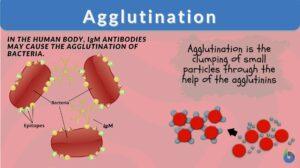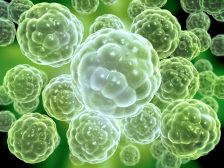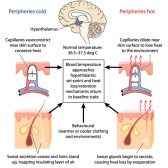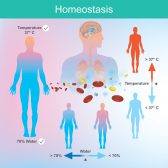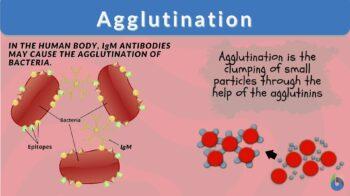
Agglutination
n., from the Latin “agglutinare”, meaning “to glue to”
The clumping of small particles suspended in a solution
Table of Contents
Agglutination Definition
What does agglutination mean? It generally refers to the process of sticking together or the adhesion of small particles, especially those suspended in a solution. But what is agglutination in biology? Biological agglutination is the clumping of cells as aided by agglutinins. Agglutinins are substances in the blood that induce agglutination. Examples of agglutinins are antibodies and lectins.
In microbiology and immunology, the term particularly refers to the bacterial cells that clump in the presence of an antibody or a complement. It may also refer to the foreign particles and cells that clump to prevent them from interfering with the normal physiological processes of the body. Agglutination is, therefore, a vital immune response of the body.
Understanding the process of agglutination is crucial because of its medical implications. For instance, an individual needing a blood transfusion should not be given the wrong blood group. Otherwise, the result will be the clumping of blood cells, which can be fatal to the recipient. (For more info, read the section: Laboratory Applications).
Etymology: from the Latin agglutinare, meaning “to glue to”.
Agglutination Examples
Watch this vid for examples of agglutination
Agglutination of red blood cells
The agglutination of red blood cells (RBCs) is specifically called hemagglutination. What causes the agglutination of RBCs can be attributed to hemagglutinins (a group of agglutinins). Hemagglutinins are glycoproteins that cause the red blood cells to stick together. For example, the red blood cells will agglutinate in the presence of certain dietary lectins.
Phytohemagglutinin (PHA), a lectin from plants, especially legumes, is an example. Eating raw or insufficiently cooked red kidney beans (which are rich in PHA) may lead to hemagglutination.
Agglutination of bacteria
Microbes tend to clump in the presence of certain antibodies that bind them together. (Ref. 1) The presence of agglutinins is what makes agglutination by antibodies possible. To define and describe the process further, see the diagram below.
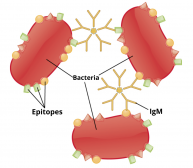
Despite the anatomy of the skin, microbes may still enter the body. Fortunately, the body has various immune defense mechanisms that will act upon them and prevent them from causing disease. One of them is opsonization. Once the antibodies detect their presence, they will “coat” the microbes, making them “sticky”. As a result, the microbial cells will agglutinate, resulting in the formation of microbial-antibody clumps. Opsonization enhances the phagocytic action of macrophages and other phagocytes.
Laboratory Applications
The principle behind hemagglutination is used in the laboratory as a basis to detect the blood type of an individual. Humans have four major blood types: Type A, Type B, Type AB, and Type O. The blood type will depend on the presence or absence of particular antigens on the surface of their RBCs.
Determining which type of blood a person has based on the antigens present on the RBCs is done usually through the forward typing method. The test can also be used to determine if the Rh factor (another cell surface antigen) is present as well. The presence of Rh factor on the surface of the RBC further classifies blood types as either Rh positive (Rh+) or Rh negative (Rh-). How is the test performed?
A blood sample from the patient will be mixed with commercially-prepared antibodies. How the blood reacts will determine the blood type. Below is a sample of a blood typing card. Based on the blood-antibody reaction, the results indicate an (A+) blood type. The RBCs agglutinate with anti-A but not with anti-B antibodies. It also indicates positive for Rh factor as the RBCs agglutinated in the presence of anti-Rh (D) antibodies.

The method described above is the direct way of determining blood type. An indirect method is back-typing. The serum from the patient will be tested for the presence of antibodies that will react to known blood types. Following the above example, a blood type A individual will have a serum containing anti-B antibodies. (Ref. 2) Thus, the serum sample will cause type B blood to stick together but not type A blood. This is why it is important not to transfuse blood to a patient with the wrong blood type.
Other examples of the laboratory application of hemagglutination are the hemagglutination assay (HA) and the hemagglutination inhibition assay (HI). By applying the principle of hemagglutination, they can measure the levels of viruses, bacteria, or antibodies in the sample. (Ref. 3)
Agglutination vs Coagulation
Both agglutination and coagulation pertain to the sticking together of particles in a suspension. Nevertheless, they differ in certain aspects. The main difference between agglutination and coagulation is the complexity of the process. Agglutination is a process that ends in the formation of a clump.
In coagulation, the process entails a more complex process such that a platelet plug forms initially, and then is subsequently reinforced with a fibrin clot. Nevertheless, considering the general definition of agglutination, which is the clumping of particles, agglutination, apparently, is a part of the coagulation process, particularly during the adhesion of platelets. When a blood vessel wall is injured, the platelets are activated.
Through the aid of the von Willebrand factor, the platelets stick together and to the blood vessel wall to form a plug to the wound site. (Ref. 4) After the sticking together of platelets, the coagulation process proceeds to the next step, which is the deposition of a protein mesh made up of fibrin (called the fibrin clot, which eventually dissolves when the blood vessel wall is healed). (Ref. 4)
Take the Agglutination Biology Quiz!
References
- DM Lab 04. (2020). Lsuhsc.Edu. https://www.medschool.lsuhsc.edu/Microbiology/DMIP/dmex04.htm
- Blood typing: MedlinePlus Medical Encyclopedia. (2013). Medlineplus.Gov. https://medlineplus.gov/ency/article/003345.htm
- Hirst, G. K. (1942). THE QUANTITATIVE DETERMINATION OF INFLUENZA VIRUS AND ANTIBODIES BY MEANS OF RED CELL AGGLUTINATION. The Journal of Experimental Medicine, 75(1), 49–64. https://doi.org/10.1084/jem.75.1.49
- The Blood Clotting Process. (2020). HemAware. https://hemaware.org/bleeding-disorders-z/blood-clotting-process
©BiologyOnline. Content provided and moderated by BiologyOnline Editors.

